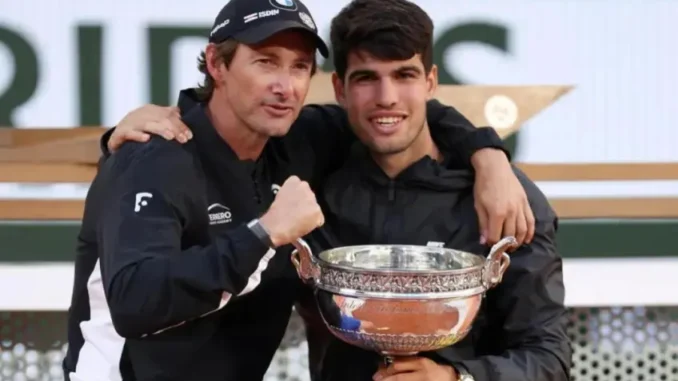
As the red clay season looms on the horizon, a tennis legend has issued a stark warning to one of the sport’s brightest young stars. Mats Wilander, a seven-time Grand Slam champion and former world No. 1, has turned his seasoned gaze toward Carlos Alcaraz, the 21-year-old Spanish phenom who’s already carved out a formidable legacy with four major titles under his belt. With the European clay swing kicking off at the Monte-Carlo Masters in April 2025, Wilander’s words carry the weight of experience—and a touch of concern. He’s not doubting Alcaraz’s talent, but rather spotlighting a hurdle that could define the reigning French Open and Wimbledon champion’s career: inconsistency. For a player who’s dazzled the world with his flair, the clay courts could either be a proving ground or a pitfall, and Wilander’s cautionary tale is one Alcaraz can’t afford to ignore.
Alcaraz’s 2024 season was a testament to his brilliance—securing Roland Garros and defending his Wimbledon title against Novak Djokovic in a five-set epic—but it’s been far from flawless. The young Spaniard, currently ranked No. 3, has stumbled in recent months, with early exits at tournaments like Indian Wells, Miami, and a shocking second-round loss to Botic van de Zandschulp at the US Open. These setbacks have fueled a narrative of unpredictability, and Wilander sees it as a thread that could weave through Alcaraz’s entire career. “I think Carlos Alcaraz is going through what Carlos Alcaraz will be going through for the rest of his career, which is that there are going to be inconsistencies,” Wilander remarked, his tone a blend of admiration and realism. He’s not writing Alcaraz off—far from it—but he’s pointing to a pattern that could trip up even the most gifted of players if left unchecked.
The clay season, with its grueling physical demands and tactical nuances, is a crucible that tests every facet of a player’s game. Alcaraz, who grew up on the red dirt of Murcia, has already proven he can thrive there, clinching the French Open in 2024 with a comeback victory over Alexander Zverev. Yet Wilander isn’t convinced it’s his strongest suit. “Even though he won Roland Garros last year, I’m not sure clay is his best surface,” he mused, suggesting that Alcaraz’s explosive, all-court style might shine brighter on faster surfaces like grass or hard courts. Still, he doesn’t rule out another triumph in Paris: “It wouldn’t surprise me at all if he goes and wins the French Open again, because that’s the quality that he brings.” It’s a paradox that defines Alcaraz—capable of miracles one moment, vulnerable the next.
Wilander’s warning isn’t just about surface preferences; it’s about temperament and adaptability. He compares Alcaraz to Andre Agassi, another prodigious talent who oscillated between brilliance and baffling defeats—“winning tournaments and Grand Slams, and then suffering early-round exits, especially in Europe.” For Alcaraz, the Monte-Carlo Masters will be his first clay test of 2025, a tournament where he’s yet to claim a victory. A strong showing could silence the doubters and set the tone for a dominant run through Barcelona, Madrid, and Roland Garros, where he’ll defend his crown. But a stumble could amplify the whispers of inconsistency that have trailed him since his Miami meltdown against David Goffin, where he admitted, “After the first set, I thought I was going to be better,” only to watch his game unravel.
What makes Alcaraz so compelling—and so confounding—is his ability to pull off the improbable. “He’s going to pull off some miracles at times, and then those miracles are going to help him win matches,” Wilander noted, recalling moments like Alcaraz’s jaw-dropping drop shots and lobs against Zverev in Paris. Yet, he warns, “He’s going to pull off miracles at different times, and he’s not going to win the match in the end.” It’s a tightrope walk between genius and gamble, and the clay season will demand more than just flashes of brilliance—it’ll require the stamina and strategy that icons like Rafael Nadal and Djokovic have mastered over decades. Alcaraz, coached by Nadal’s former mentor Juan Carlos Ferrero, has the tools, but Wilander wonders if he’s ready to wield them consistently.
As the tennis world turns its eyes to Monte-Carlo, the stakes couldn’t be higher for Alcaraz. A faltering start could embolden rivals like Jannik Sinner—who’s sidelined by a doping ban until mid-2025—and Alexander Zverev, who sit ahead of him in the rankings. But a resurgence could propel him back toward the No. 1 spot he’s held before. Wilander’s faith in Alcaraz’s potential remains unshaken—“He could bounce back within two weeks because of the way he plays tennis”—but his caution is a clarion call. The red clay season isn’t just another chapter; it’s a proving ground where Alcaraz must show he can marry his prodigious talent with the discipline to match. For now, the tennis faithful wait, breathless, to see if the Spaniard heeds the warning—or writes his own redemption story, one clay court at a time.
Leave a Reply